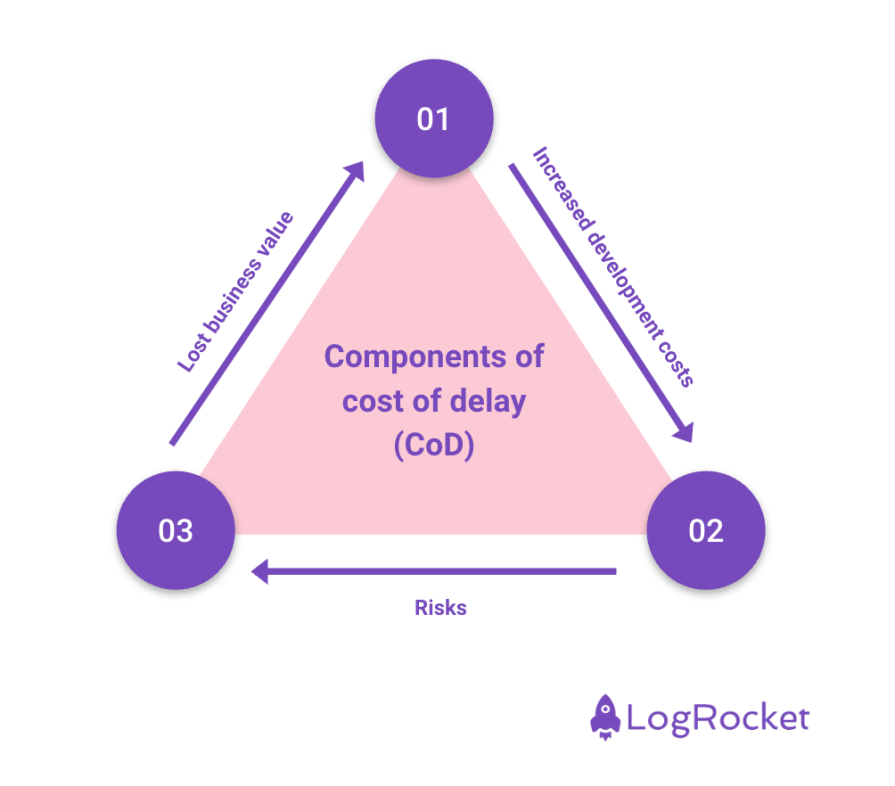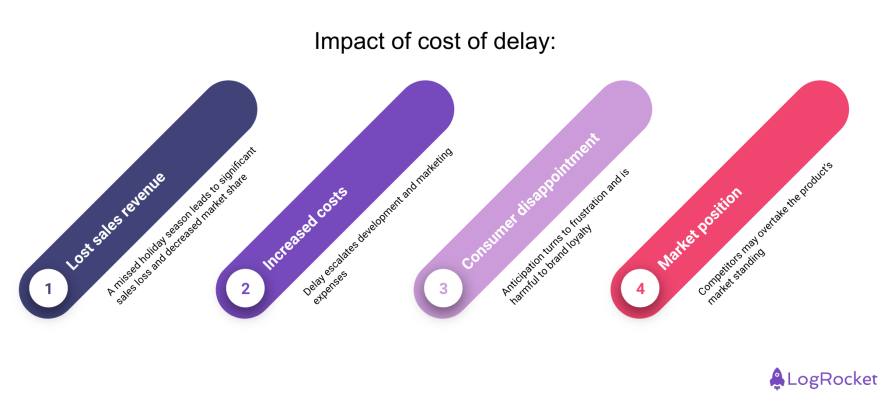In the realm of project management timelines, “cost of delay” is a pivotal yet overlooked factor. It directly influences project success in multiple ways by examining the impact of costs and deadlines on value creation. This data is vital for a product manager and can help you make more informed decisions about your processes moving forward.

Today you’ll learn what the “cost of delay” framework is, why it’s so important, and how it impacts business dynamics and project timelines.
Cost of delay (CoD) strategy quantifies the financial impact of time in relation to the outcome of the project. It measures the cost of not delivering a project (or a part of it) by a certain deadline.
It emphasizes the lost opportunities and sheds light on:
In simple words, each delay in a project’s timeline costs resources to the organization. Additionally, it results in strained relationships with stakeholders and miscommunication between internal teams.
It’s essential to develop an understanding of the key components of the cost of delay metric and how they’re related to project timelines.
The cost of delay strategy has certain key components that are related to each other. Understanding these components can help you prioritize projects, mitigate risks, and optimize resource allocation:

Lost business value refers to the revenue or benefits the company missed out on due to the delays. This factors in a range of elements like diminished market shares, lost sales, and forgone interest in products, etc.
Delays are risky in multiple ways. They can hinder team communications and also inflate the budget significantly. In simple words, it leads to increased overheads, and labor costs that can lead to complications.
The potential risks can take the shape of two scenarios, either existing risks can exacerbate or new ones can appear. The longer the project takes, the more uncertainty will seep into the workflow.
With a thorough understanding of these components, you can plan effective strategies to avoid criticalities earlier.
Recognizing the intricate relationship between these components allows businesses to devise more effective strategies to tackle delays.
Calculating cost of delay involves quantifying the financial impact of delays. This calculation can range from simple and straightforward to complex, depending on the nature and scope of the project at hand.
Let’s look at the fundamental approach used as a standard guideline:
The simple formula involves two elements, one is an assessment of the expected value (revenue) a project generates over a specific period, and the other is the lost value per unit of time.
CoD = (lost revenue or value per time unit) × (delay duration)
For example:
If a new product is expected to generate $100,000 per month and its launch is delayed by two months, the CoD would be:
Cost of delay = $100,000 × 2 = $200,000
For complex cases, the CoD calculation depends on many factors and they keep evolving over the course of the project. Considering some basic guidelines will be a good starting point for most CoD calculations:
The concept of CoD is versatile and has many applications. One example is how it relates to different project management methodologies.
Its role varies depending on several factors. The methodology’s focus, principles, and practices often dictate the application of CoD with it. Let’s explore a few:
CoD isn’t just theoretical but it has real-world implications.
Consider the following: A consumer electronics company is set to launch a new smart home device. This device integrates with existing home ecosystems.
Due to unforeseen issues in software development and compatibility issues, the product launch is delayed by six months. This delay can impact the product in the following ways:

Another common example can be of a gaming company. It delayed a highly anticipated video game’s fall release by three months. This caused it to miss out on the holiday season and for competitors to capture its market. This led to increased development, marketing costs, and fan disappointment.
Quantifying cost of delay involves a strategic calculation approach. You should use a combination of qualitative and quantitative data, including projected revenue losses, increased overhead, and inflated operational costs.
There are many useful tools to quantify CoD, like financial modeling, risk analysis, and feedback loops. It also helps with maintaining stakeholder communication transparency and fosters a culture of growth within the organization.
Cost of delay is never truly eliminated in the project lifecycle but there are ways to minimize it and its harmful impact. These require proactive and strategic planning.
Some key strategies include:
Understanding and managing the cost of delay is fundamental to achieving project success. It helps products maintain a competitive edge in today’s dynamic business environment. These insights will help you in every aspect of delay management:
Featured image source: IconScout

LogRocket identifies friction points in the user experience so you can make informed decisions about product and design changes that must happen to hit your goals.
With LogRocket, you can understand the scope of the issues affecting your product and prioritize the changes that need to be made. LogRocket simplifies workflows by allowing Engineering, Product, UX, and Design teams to work from the same data as you, eliminating any confusion about what needs to be done.
Get your teams on the same page — try LogRocket today.

A practical framework for PMs to use AI in ideation without sacrificing judgment, strategy, or decision quality.

A practical five minute revenue estimation method to help product managers compare ideas, drop low impact features, and prioritize smarter.

A practical guide for PMs who want to stop being bottlenecks, delegate smarter, and lead teams effectively with a clear ownership framework.

Stop letting unreliable data block features. Treat data as inventory to track quality, ownership, and ship with confidence.